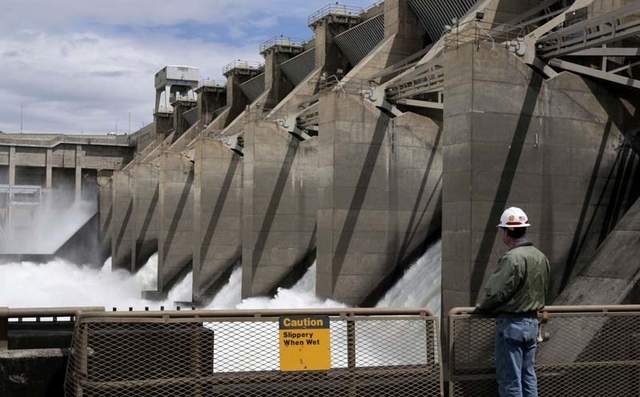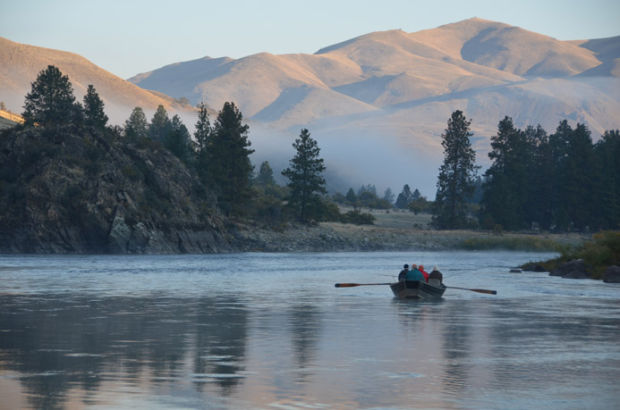forum
library
tutorial
contact

Latest NOAA Opinion on Salmon
Goes Back to Well
by Eric Barker
Lewiston Tribune, January 18, 2014
|
the film forum library tutorial contact |

|
Latest NOAA Opinion on Salmon
by Eric Barker
|
 The new plan is the same as the old plan, according to critics of the federal government's latest attempt to ensure its dams on the Snake and Columbia rivers don't jeopardize the survival of threatened salmon runs.
The new plan is the same as the old plan, according to critics of the federal government's latest attempt to ensure its dams on the Snake and Columbia rivers don't jeopardize the survival of threatened salmon runs.
The Fisheries branch of the National Oceanic and Atmospheric Administration released a biological opinion Friday that said improvements to habitat in spawning tributaries and the Columbia River estuary, combined with spillway weirs that help fish pass through the hydrosystem, can boost productivity enough to make up for fish killed at the dams.
"This supplemental biological opinion confirms we are on the right track when it comes to ensuring the survival of salmon and steelhead species in the Columbia River system now and well into the future," said Will Stelle, West Coast Regional Administrator for NOAA Fisheries.
Because there are 13 populations of threatened and endangered fish runs in the basin - including spring chinook, fall chinook, steelhead and sockeye that spawn in the Snake River and its tributaries - the Endangered Species Act requires the agency to ensure operation of the dams doesn't put those fish at further risk of extinction.
The agency has issued four such biological opinions, commonly called BiOps, in the past two decades. But each one was struck down by Judge James Redden, who deemed them to be insufficient. That last happened in 2011, when the judge said the agency depended on benefits from habitat improvement projects that were too ill-defined to pass muster with ESA. Redden also said the agency should at least consider dam breaching and increasing spill at the dams.
But the strategy included in the new BiOp is virtually identical to that of its previous versions. It does not analyze breaching, and while it discusses a proposal to dramatically increase spill at the dams, it instead adopts policies that would curtail spill in late summer.
The Nez Perce Tribe, one of the plaintiffs in previous court challenges, called the document disappointing.
"It's immediately clear that the BiOp's foundation is fatally flawed," said Silas Whitman, chairman of the Nez Perce Tribe's governing body. "The BiOp fails to fully analyze the impacts of these dams on both the survival and recovery risks to ESA-listed salmon and steelhead, and, as a consequence, allows the federal action agencies to avoid taking additional actions for the fish."
 Environmental groups also said the agency whiffed on its latest attempt.
Environmental groups also said the agency whiffed on its latest attempt.
"The two years since the last plan was ruled illegal were an opportunity to build a foundation for collaborative talks leading to durable solutions that benefit salmon, people and the economy," said Greg Stahl of Idaho Rivers United at Boise. "This plan won't help us move in that direction."
Terry Flores of Northwest River Partners sharply disagreed. The executive director of the group that is an alliance of farmers, utilities, ports and businesses, praised the effort as scientifically sound and collaborative.
"We think the plan is solid and the science has been proven and vetted over and over again and, more than that, we have experienced, over the last decade, some really robust salmon returns with the best example being the historic fall chinook returns we saw last year," Flores said.
Barry Thom, deputy regional director for NOAA Fisheries, also said a review of the listed runs showed they are meeting goals outlined in previous biological opinions and in many cases exceeding abundance targets. But he said returning adults have not been as productive as expected. He attributed the low productivity to the need to improve spawning and rearing habitat.
When pressed, Thom acknowledged there are vast amounts of pristine yet under-utilized habitat in the roadless and wilderness areas of central Idaho and said none of the protected runs is close to meeting recovery goals. But he said places like the Grande Ronde River and its tributaries could benefit from habitat improvements.
The biological opinion has actually been in place since 2008 while the agency has worked to make fixes ordered by Redden. It runs through 2018. Thom said the agency hopes to soon transition from the biological opinion to a more sweeping and long-term recovery plan.
Stahl said it is too early to say if the environmental groups will return to court. If they do, the case won't be decided by Redden. He retired in 2012 and was replaced by Judge Michael H. Simon.
learn more on topics covered in the film
see the video
read the script
learn the songs
discussion forum
